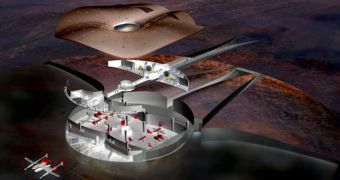While only a stuff of fantasy some years ago, Spaceport America is currently becoming a hard reality. In the remote deserts of New Mexico, bulldozers and similar machines are constructing the world's first purpose-built spaceport, a facility designed to accommodate the needs of horizontal landings and take-offs into space. The construction phase of the project is currently accelerating, and there is a great deal of optimism that the entire facility, runway and adjacent buildings included will be finished on time.
Undoubtedly, the most important feature of Spaceport America is the project's runway. It has a length of about 10,000 feet (3,050 meters), and a width of about 200 feet (61 meters). It was especially designed to handle all types of commercial spacecraft that might need to fly on it after the construction was finished. The entire structure is located approximately 45 miles (72 kilometers) North of the city of Las Cruces, in New Mexico. One of the key players in this project is the private company Virgin Galactic, which conducts suborbital, commercial flights. It will also be using the Terminal Hangar Facility, which is scheduled to be completed around 2011.
“The runway is estimated to be complete by June and at the latest August 2010. At that moment Spaceport America will be open for people to come and use the runway for their activities. The longer term view is to widen the airfield to 300 feet by 15,000 feet which would make it one of the most capable airfields in the world,” the Executive Director for the New Mexico Spaceport Authority (NMSA), Steve Landeene, explains.
“Virgin Galactic will have exclusive use of the airfield at Spaceport America which guarantees a clear runway. We also have the clear weather and the option to fly in restricted airspace or national airspace. The availability of clear airspace, low population density, clear weather, and high elevation all make Spaceport America a unique place to perform space launch activities,” he adds. “We do have plans to extend the runway to 15,000 feet in the future as well as a cross-wind runway as customer needs dictate,” Landeene concludes, quoted by Space.

 14 DAY TRIAL //
14 DAY TRIAL //